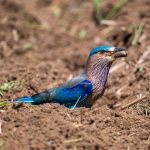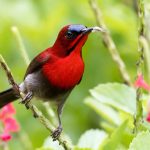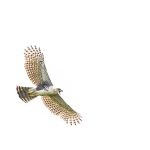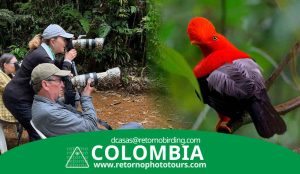We all know that birders, with our high-priced optics, tendency to travel, and obsession with field guides, spend way too much cash on our hobby. But how much, exactly, do we spend? And how much would be willing to spend, collectively, to help the birds? Both of those questions will be closer to being answered in the coming year, at least in the state of Ohio. How? Well, the first question will come closer to being answered by researcher Philip Xie, who will spend the coming year interviewing birders at six locations along the Lake Erie shoreline. The second question could be answered by the Ohio Wildlife Legacy Stamp, Ohio birdwatchers’ answer to the Federal Duck Stamp. Kimberly Kaufman ably and enthusiastically describe the new stamp from Ohio here.
Recent Posts
 Book Review: Birding with AI by Ronald T. KneuselBy Peter
Book Review: Birding with AI by Ronald T. KneuselBy Peter Bird Guides of the World: Chubzang Tangbi, BhutanBy Editor
Bird Guides of the World: Chubzang Tangbi, BhutanBy Editor Birding Lodges of the World: Birder’s Haven, Pabala Nature Reserve, South AfricaBy Editor
Birding Lodges of the World: Birder’s Haven, Pabala Nature Reserve, South AfricaBy Editor Open Country Birding around Sigiriya, Sri LankaBy Kai Pflug
Open Country Birding around Sigiriya, Sri LankaBy Kai Pflug The Chemistry of Birds (17): Chemicals in Bird ConservationBy Kai Pflug
The Chemistry of Birds (17): Chemicals in Bird ConservationBy Kai Pflug Three Photos: Singapore SunbirdsBy Kai Pflug
Three Photos: Singapore SunbirdsBy Kai Pflug October 2025 Global Big Day – 10,000 Birds EditionBy Faraaz Abdool
October 2025 Global Big Day – 10,000 Birds EditionBy Faraaz Abdool
Posting Calendar
| DAY | WRITER(S) | SERIES |
|---|---|---|
| MON | Kai (w) | Birding Lodges (w) |
| TUE | Donna (m) Susan (m) Hannah (m) Fitzroy (m) Grace (m) | Bird Guides (w) |
| WED | Leslie (bw) Faraaz (bw) | Ask a Birder (w) |
| THU | Paul (w) Cathy (bw) | Birder’s Lists (w) |
| FRI | David (w) | Species Spotlight (w) |
| SAT | Peter (bw) Luca (bw) | From the Archives (w) |
| SUN | Clive (w) Sanjana (m) | Three Photos (w) |
| w weekly, bw biweekly, m monthly | ||
| Any time: Jason, Mark, John, Sara, Rolf, Dragan | ||
See here for info on the writers.
Newsletter
Signup and receive notice of new posts!
Thank you!
You have successfully joined our subscriber list.





Thanks a ton, Corey! There are really good people behind this stamp at ODOW and I’ve seen the great projects that Wildlife Diversity Funds have made possible. It’s $15 well spent.
In addition to funding worthwhile projects, another benefit of the stamp is something that “Nate” pointed out in a comment on our blog yesterday, “we’ll be able to effectively quantify the effect of birders on conservation in a way that was difficult when we were lumped with hunters buying duck stamps.”
I certainly hope that everyone–birders and nonbirders alike–will buy this stamp, and that birders will continue to buy the Duck Stamp as well. Bu at BSBO, we sell the Duck Stamp almost exclusively to birders and we keep track of those numbers. If every birding-related organization and business did the same, we could also separate and measure birder support for the Duck Stamp as well.
I think a fabulous $67 investment in bird conservation would be: A $15 Federal Duck Stamp, a $15 Ohio Wildlife Legacy Stamp, a $25 membership to the 10,000 Birds Conservation Club, and a $12 donation to BSBO’s Donate the Guia! (dang, I hope I got the math right!!)
And to add to what I mentioned on Kim’s blog, the advantage to giving birders a means to flex their financial muscle is that we can turn that into influence in the way land is managed. I feel that’s a real issue with duck stamps alone, that it gives the impression that the only land that should be managed is that which has value primarily to hunters and game species, which birders use too, but when there’s a limited pot game species get the lion’s share and non-game species get the shaft.
We all know that there are non-game species that need help too. And maybe if we can make a concerted effort to fund efforts like this one in Ohio, we have the capital to encourage preservation of say, relict forest along the Lake Erie shore for migrating songbirds for instance. Or in my neck of the woods, dune and beach preservation for nesting shorebirds.
I love this idea. I hope other states follow suit.
I don’t know how much all Ohio birders spend, but I can give a rough figure as to how much it costs me to migrate back to my native Ohio each spring to bird along the Lake Erie shore. Add 2-3 more friends who do the same and it all adds up. Think of all the other businesses unrelated to birds or the outdoors (gas, restaurants, Wal-mart, etc) where we spend money during our yearly trip!
I completely agree with Kimberly and Nate’s thoughts as well.
Birders spend a LOT and are very, very significant economically.
During my first spring trip to Michigan in May 2005, my wife and I spent (all included, car rental, food, motels etc.) around $ 3,000 in Michigan. Had we not flown with BA but with an American airline from Europe (which could have happened easily), that figure would go up to around $ 4-5,000.
The trip was initiated by my wife’s internship at the U of M but is a trip I (we) would have done sooner or later anyway just for the birding and ONLY for the birding.
Around that time, the Kirtland’s warbler’s recovery programme was affected (or at least there was a threat) by significant funding cuts from the state. It was feared that the $10,000 per year for cowbird control in particular would not be available.
The Great Lakes region, particularly Ohio and Ontario, are surely visited by a few hundred birders from overseas each spring. Michigan is off the radar a bit because its migration hot spots are less well known than the classics Crane Creek and Point Pelee. However, most European birders make short detours into Michigan specifically for the warbler.
When we assume that roughly 10% of the money spent on such trips is spent on these warbler-specific detours in Michigan, then the income generated by just 25 or so tourists from overseas will cover the cowbird control costs. Just 25 out of a few hundred.
It doesn’t take much to calculate that quite possibly, the economic importance of the Kirtland’s warbler outweighs the management costs.